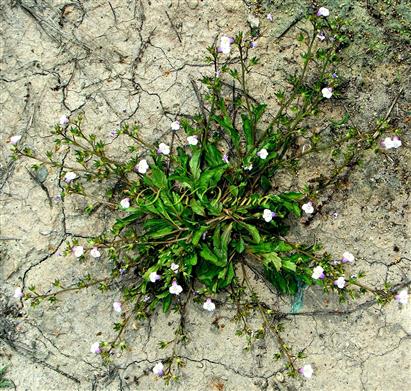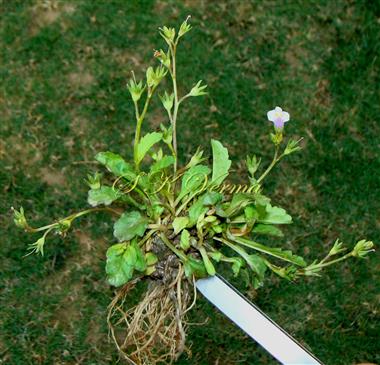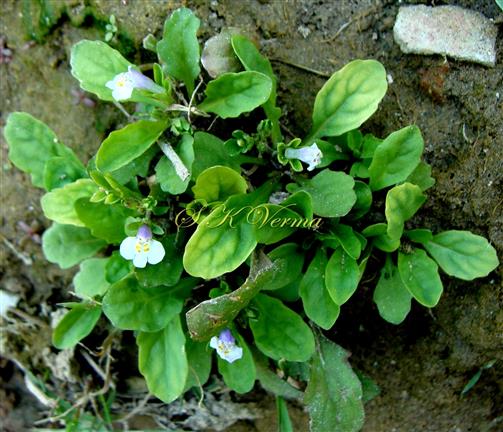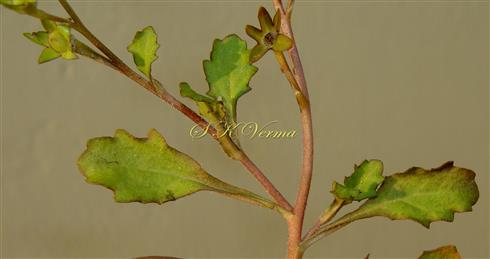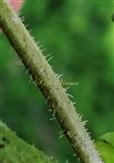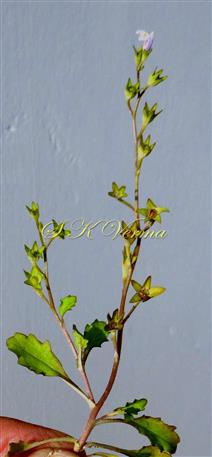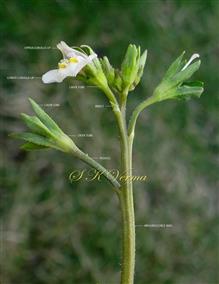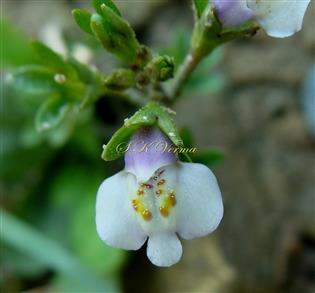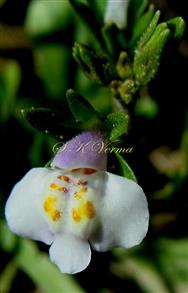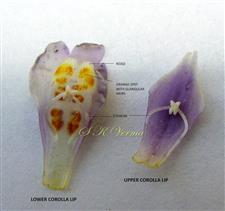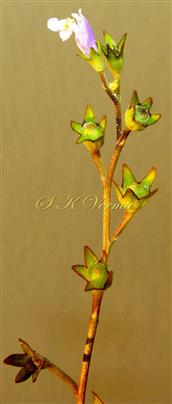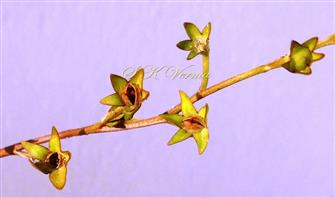MAZUS
Mazus
Lour., Fl. Cochinch. 2: 385. 1790.; Collett, Fl. Siml. ed. 2: 350. 1921 (Reprint 1980); Hook. f., Fl. Brit. Ind. 4: 259. 1885; Fl. China @eFloras.org 18: 42.
Small herbs, 5-30 cm long, glabrous or hairy. Stem terete, rarely quadrangular, erect or procumbent and rooting from lower nodes. Leaves mostly rosulate or opposite and crowded near the base of stem, upper alternate, few or none; petiole winged. Flowers small, bisexual, zygomorphic, hypogynous, in terminal racemes, racemes secund; bracts small; bracteoles present or absent. Calyx campanulate or funnelform, 5-lobed or 5-toothed, persistent. Corolla 6-12 mm long; tube short; limb 2-lipped; upper lip (adaxial or posterior) erect, 2-lobed; lower (abaxial or anterior) much larger, spreading, 3-lobed, with 2 prominent glandular ridges at the base. Stamens 4, didynamous, inserted on corolla tube, included; anther thecae divergent, apically connivent. Ovary hairy or glabrous; style glabrous; stigma flat, 2-lobed or 2-lamellate. Capsule globose, compressed, included in cupulate persistent calyx, loculicidal. Seeds small, numerous.
40 species
Mazus pumilus
Mazus pumilus
(Burm. f.) Steenis, Nova Guinea n.s. 9: 31. 1958; Shah, J. Bomb. Nat. Hist. Soc. 66: 233. 1969; Chowdhery in Chaudhary & Wadhwa, Fl. Himachal Pradesh 2: 523. 1984; Kaur & Sharma, Fl. Sirmaur 466. 2004; Singh & Sharma, Fl. Chamba Dist. 513. 2006; Fl. China @ eFloras.org 18: 46; M. japonicus (Thunb.) Kuntze, Rev. Gen. Pl. 2: 462. 1891; Nair, Fl. Bashahr Himal. 204. 1977; M. rugosus Lour., Fl. Cochinch. 385. 1790; Hook. f. Fl. Brit. Ind. 4: 259. 1885; Collett, Fl. Siml. ed. 2: 351.f.110. 1921 (Reprint 1980).
Annual herb, 2-15 cm high, stolons absent. Stems 1-many, erect, ascending or prostrate, sometimes branched near base, pubescent. Basal leaves 1.5-5.5 cm x 0.8-1 cm, oblanceolate, obovate-spathulate or oblong, narrowed into petiole-like base with wing, margin coarsely toothed or crenate, petiole margin ciliate; both surfaces glabrous or pubescent along veins abaxially, adaxially short-hairy proximally. Cauline leaves opposite, uppermost often alternate, morphologically similar to basal leaves. Racemes scapose or terminating erect stems up to 12 cm long; flowers white or white with shades of pale blue, bisexual, zygomorphic, hypogynous, 2-lipped. Pedicels 5-10 mm long, sparsely hairy; bracts 2-3 mm long, linear- subulate. Calyx 4.5-6.5 mm long, up to 9 mm in fruit, funnelform, sparsely pubescent without; tube 2-3 mm long; lobes 5, 3-4 mm long, ovate-lanceolate, acute. Corolla 9-10 mm long; tube short, ca. 4 mm long and 3 mm wide, glandular, pale blue; limb 2-lipped; upper lip erect, small, ca. 3 mm long, 2-lobed; lower lip ca. 6 mm x 7 mm, projecting, spreading, 3-lobed, middle lobe smaller (ca. 2 mm x 2 mm) than the 2 laterals ( ca. 5 mm x 3 mm ), slightly exserted, obovate; median part with 2 prominent ridges with clavate glandular hairs, white with shades of pale blue and orange spots in throat. Stamens 4, didynamous, inserted in corolla tube, included, abaxial pair longer than the adaxial pair, anther thecae divaricate, connivent apically. Ovary ovoid or globose, glabrous, 2-locular, many ovules; style glabrous, longer than calyx; stigma flat, 2-lobed. Capsule 2-3 mm x ca. 2 mm, globose, compressed, loculicidally 2-valved, included in persistent cupulate calyx. Seeds small, ca. 0.5 x 0.3 mm.
Common Names: Asian Mazus, Japanese Mazus
